Explore Suncheon - South Korea Travel, Asia
Suncheon, is a city known for its rich natural beauty, cultural heritage, and agricultural significance. Located in South Jeolla Province in southern South Korea, approximately 40 minutes north of the port city of Yeosu. The city is surrounded by mountains and is near the coast, providing a scenic backdrop and favorable conditions for agriculture and tourism. Its history stretches back to ancient times, having been part of the Mahan territory before going through several name changes during the Baekje, Unified Silla, and Goryeo periods. In 1413, it officially became Suncheon Dohobu during the Joseon Dynasty. A notable moment in its modern history is the Yeosu-Suncheon Rebellion in 1948, a significant uprising against the South Korean government.
Seeking a tailored South Korea adventure? Explore our premium Japan tour offerings here.
Population: approximately 280,000 as of 2024.
Economy: Suncheon has developed a strong tourism sector, attracting visitors to its natural attractions, such as Suncheon Bay and the Suncheon Bay National Garden. The city hosted the 2013 Suncheon Garden Expo, which showcased its commitment to green industry and sustainable tourism. The Suncheon Bay Wetland Reserve is also a major draw for eco-tourism.
Landmarks: Suncheon Bay National Garden, Suncheon Bay Wetland Reserve, Nagan Eupseong Folk Village, Suncheonman Bay Ecological Park, Deep-Rooted Tree Museum, Suncheon Open Film Location
South Korea
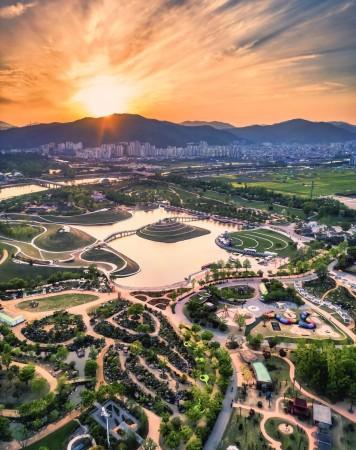
Overview of Suncheon
History & Culture Influence
Suncheon has a rich history that dates back to the Era of Samhan when it was part of the Mahan Confederacy. Throughout the Three Kingdoms period, it was known as a territory of Baekje, and later, during the Unified Silla, it became known as Seungpyeong-gun in 757. The city underwent various name changes and administrative reorganizations over the centuries, reflecting its evolving role in Korean history. In the modern era, Suncheon experienced significant turmoil during the Yeosu-Suncheon Rebellion in 1948, a pivotal event in Korean history that highlighted social and political tensions in the post-liberation period. This rebellion influenced local governance and community dynamics. Suncheon's cultural identity is shaped by its historical significance and natural beauty. The city is known for its commitment to environmental sustainability, particularly through the conservation of Suncheon Bay, recognized for its rich biodiversity and ecological value.
Interaction with The Locals
The city's population is relatively homogeneous, reflecting the overall demographic trends in South Korea. Suncheon is a popular tourist destination, particularly for its natural attractions such as Suncheon Bay and Suncheon Bay National Garden. As a result, locals are accustomed to interacting with visitors and are generally friendly and helpful. The city's focus on ecotourism and sustainable development has fostered a positive attitude towards tourists who appreciate and respect the local environment.
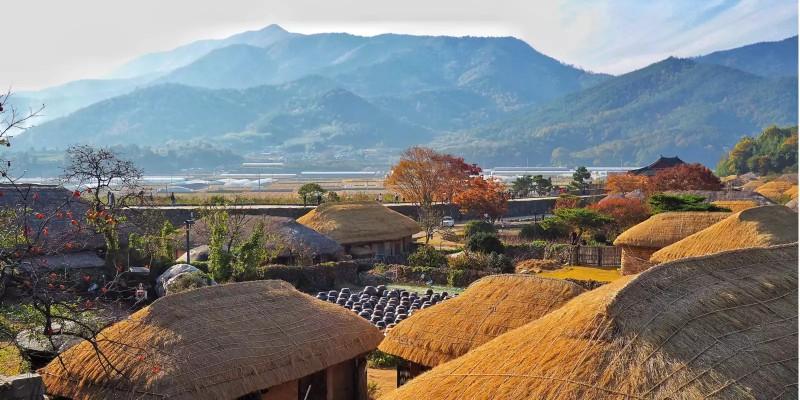
Nagan Eupseong Folk Village - © Daum Korea
Top attractions in Suncheon
Suncheon Bay National Garden
Suncheon Bay National Garden is a breathtaking 1.12 km² garden that was established to protect the delicate Suncheon Bay wetlands. This sprawling garden boasts an impressive collection of themed areas such as the Arboretum, World Garden Zone, and Wetland Zone. With over 860,000 trees and 650,000 vibrant flowers, it’s a must-see destination in every season, offering stunning displays of nature. The garden also serves as a gateway to the nearby wetlands, making it a perfect starting point for eco-friendly travelers.
Suncheon Bay Wetland Reserve
Home to an incredible variety of wildlife, Suncheon Bay Wetland Reserve is one of South Korea’s most significant coastal wetlands. Visitors can explore scenic walking trails and observation decks to take in the beauty of this thriving ecosystem, which houses over 1,400 species of plants and animals. A unique feature is the Sky Cube, a personal rapid transit system that conveniently connects the wetland reserve to the Suncheon Bay National Garden, offering an eco-friendly and scenic ride.
Nagan Eupseong Folk Village
Step back in time at Nagan Eupseong Folk Village, one of Korea's best-preserved traditional villages from the Joseon Dynasty. The village is surrounded by an ancient fortress wall and dotted with thatched-roof houses, showcasing authentic Korean architecture. Visitors can immerse themselves in the historical ambiance, experiencing traditional crafts, local foods, and scenic views of the surrounding landscape.
Jogyesan Mountain
Jogyesan Mountain offers nature lovers an escape into beautiful landscapes, serene hiking trails, and cultural history. One of the highlights of the area is Seonamsa Temple, a stunning Buddhist temple with a history dating back to the 9th century. The mountain’s peaceful environment, combined with its scenic beauty, makes it a perfect destination for those looking to hike, reflect, or explore Korea's spiritual heritage.
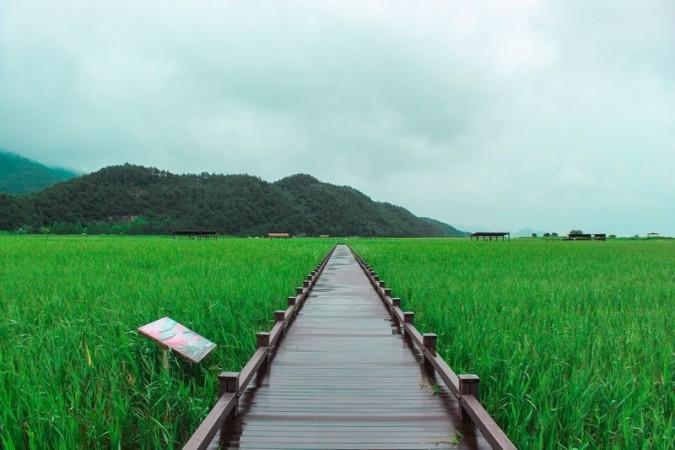
Suncheon Bay Wetland Reserve - © The Soul of Seoul
Must-Try Dishes in Suncheon
Suncheon offers a variety of must-try dishes that showcase the region's fresh ingredients and culinary heritage and highlight the unique Suncheon's coastal flavors.
- Suncheon Bibimbap: Suncheon Bibimbap is a must-try dish that perfectly represents the region’s fresh produce and culinary style. This colorful meal combines seasoned vegetables, beef, and a raw or fried egg, all beautifully arranged over warm white rice. Often accompanied by Suncheon’s famous namul (seasoned vegetables), the dish is both a feast for the eyes and a harmonious blend of flavors.
- Suncheon Makguksu: A refreshing favorite during the hot summer months, Suncheon Makguksu is a cold buckwheat noodle dish served with toppings like cucumber, boiled egg, and spicy gochujang sauce. The light, chilled broth makes this dish a perfect choice for cooling down, and it can be found in many of Suncheon’s local restaurants.
- Suncheon Pork Rice Soup: This comforting soup, known for its clean, non-greasy flavor, is made with tender pork, bean sprouts, and rice simmered in a savory broth. Often served with boiled pork as a side dish, Suncheon Pork Rice Soup is a local favorite for breakfast or lunch, and it’s renowned for its ability to cure hangovers.
- Suncheon Cockle Dishes: Known for its high-quality seafood, Suncheon boasts some of the best cockle dishes in Korea. Visitors can enjoy a variety of preparations, including sweet and sour cockle salad, steamed cockles, and blanched cockles served with rice, highlighting the city’s coastal bounty and fresh flavors.
- Suncheon Mudskipper Fish Soup: Mudskipper fish, found in Suncheon Bay’s mudflats, is the star of this spicy soup, believed to boost health and relieve travel fatigue. Boiled with vegetables and spices, Suncheon Mudskipper Fish Soup offers a unique, nutritious experience for adventurous food lovers.
Curious about the scenic beauty of Buyeo? Find out what makes it so special here in our in-depth travel guide.
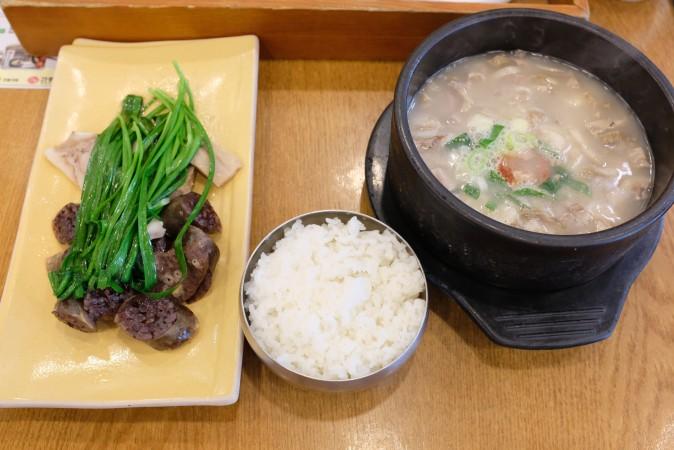
Suncheon Pork Rice Soup - © Hi There Im Jun
Festivals & Local Celebrations
- Suncheon Bay Reed Festival: Celebrate the breathtaking beauty of Suncheon Bay’s golden reeds during this vibrant festival. Visitors can enjoy a range of cultural performances, art exhibitions, and interactive activities, all set against the stunning backdrop of one of Korea’s most significant wetlands.
- Suncheon Cultural Heritage Night: Immerse yourself in Korean traditions at Suncheon Cultural Heritage Night, where you can experience live performances, traditional crafts, and authentic cuisine. This evening event brings to life the rich cultural legacy of Suncheon and its surrounding regions.
- Suncheon Food & Art Festival: This lively festival blends the best of Suncheon’s culinary scene with local artistic talent. Visitors can indulge in delicious regional dishes while enjoying art exhibitions and live performances that showcase the creative spirit of the city.
- Naganeupseong Folk Village Culture Festival: Step back in time at the Naganeupseong Folk Village Culture Festival, where traditional games, performances, and hands-on workshops celebrate the cultural history of Suncheon. The historic village provides a perfect setting for this unique cultural experience.
- Starlight Festival: For astronomy lovers, the Starlight Festival offers an unforgettable night of stargazing, educational talks, and interactive activities. Set beneath the clear skies of Suncheon, this festival showcases the beauty of the stars while offering a peaceful escape into nature.
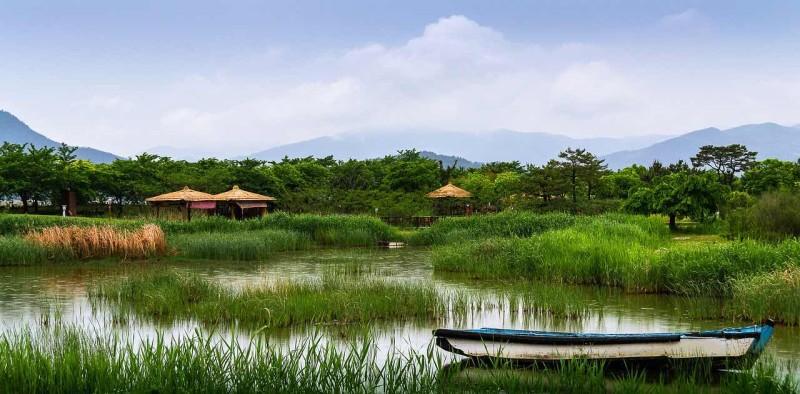
Suncheon Bay Reed - © ITASEOUL
What to Do in Suncheon
- Explore Suncheon Bay Wetland Reserve: Visitors can enjoy the stunning natural beauty of the Suncheon Bay Wetland Reserve, which is home to diverse flora and fauna. The reserve offers walking trails and observation points for birdwatching, especially during migratory seasons. This eco-friendly destination is perfect for nature lovers and photographers.
- Visit Nagan Eupseong Folk Village: Nagan Eupseong Folk Village is a well-preserved traditional village that provides a glimpse into Korea's past. Visitors can explore thatched-roof houses, fortress walls, and experience traditional Korean culture. The village often hosts cultural events and workshops, allowing tourists to engage with local customs.
- Hike Jogyesan Mountain: For outdoor enthusiasts, hiking Jogyesan Mountain offers beautiful views and a chance to connect with nature. The trails vary in difficulty, making it accessible for different skill levels. The mountain is also home to the serene Songgwangsa Temple, adding a cultural element to the hike.
- Tour the Suncheon Open Film Set: The Suncheon Open Film Set is an outdoor film set that recreates urban and rural scenes from the 1950s to 1970s. Visitors can explore the various sets used in popular Korean dramas and films, making it a unique experience for fans of Korean cinema. Guided tours are available, providing insights into the filmmaking process.
- Enjoy Local Cuisine: Suncheon is known for its delicious local dishes, including Suncheon Bibimbap and fresh seafood. Visitors can explore local markets and restaurants to sample traditional Korean cuisine. The vibrant food scene offers a chance to experience the flavors of the region.
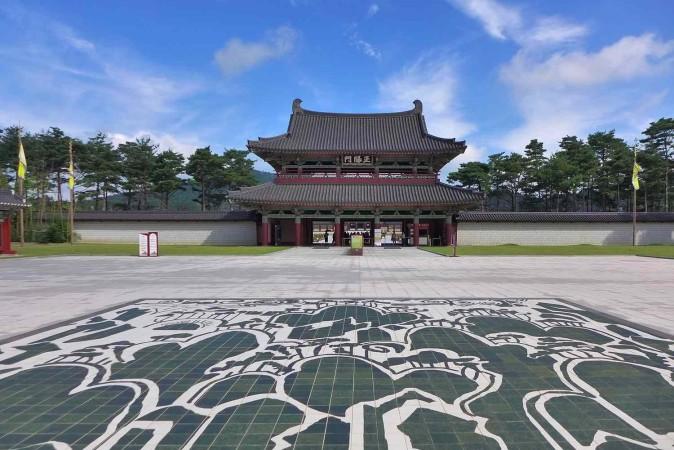
Baekje Cultural, Suncheon - © ThoughtCo
Weather in Suncheon: Best Time to Visit
Average Temperatures
- Summer (June to August): Average highs range from 25°C (77°F) in June to 30°C (86°F) in August. Average lows are around 21-22°C (70-72°F) during these months.
- Autumn (September to November): Average highs decrease from 27°C (81°F) in September to 14°C (57°F) in November. Average lows range from 17°C (63°F) in September to 4°C (39°F) in November.
- Winter (December to February): Average highs range from 6°C (43°F) in January to 11°C (52°F) in February. Average lows can drop to -1°C (30°F) in January.
- Spring (March to May): Average highs increase from 12°C (54°F) in March to 22°C (72°F) in May. Average lows range from 2°C (36°F) in March to 13°C (55°F) in May.
Best Time to Travel
The best times to visit Suncheon are during spring (April to May) and autumn (September to October). During these months, visitors can enjoy mild temperatures, beautiful natural scenery, and fewer crowds. Spring is particularly famous for cherry blossoms, while autumn showcases stunning fall foliage.
Looking to add more adventure to your journey? Danyang awaits with unique experiences—explore more here.
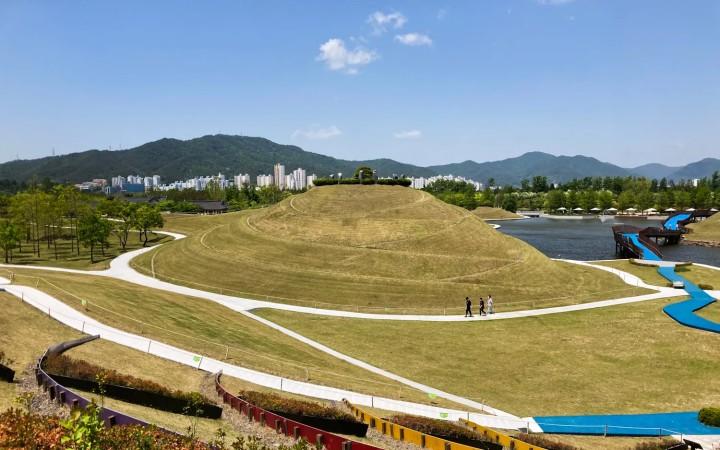
Suncheon Bay National Garden - © Roamad
Essential Travel Information
Getting Around Suncheon
- Train Services: Suncheon is accessible via the KTX and regular trains. From Gwangju Songjeong Station, there are trains that run to Suncheon Station, taking about 1 hour .
- Public Transit: Frequent intercity buses operate from major cities like Gwangju and Yeosu to Suncheon. The bus ride from Gwangju takes approximately 1 hour and 30 minutes. Tickets can be reserved online .
- Buses: Suncheon has a reliable public bus system that connects major attractions and neighborhoods. Buses are a convenient way to navigate the city.
- Taxis: Taxis are widely available throughout Suncheon. They are a convenient option for getting around, especially for visitors with luggage or those traveling in groups. Fares start at approximately ₩3,800, with metered rates applying thereafter.
ATM & Banking Services
In Suncheon, accessing banking services is convenient for both locals and travelers. Numerous ATMs are scattered throughout the city, providing easy withdrawal of cash in various currencies. Major banks have branches in key areas, offering services such as currency exchange, account management, and financial consultations. Many establishments, including restaurants and shops, accept credit and debit cards, making transactions hassle-free.
Where to Stay in Suncheon
- Luxury Resorts: If you're looking to indulge, Suncheon offers upscale resorts that provide premium services and stunning views of the surrounding landscapes. These luxury accommodations often feature spa facilities, fine dining restaurants, and spacious rooms with modern amenities.
- Eco-Friendly Lodgings: Given Suncheon's commitment to sustainability and nature conservation, eco-friendly accommodations are becoming increasingly popular. These lodgings prioritize environmentally friendly practices, offering guests a chance to enjoy a guilt-free stay amidst nature.
- Traditional Hanok Stays: These charming accommodations allow you to immerse yourself in the local culture and enjoy unique architectural features. Many hanok stays are located near attractions such as the Suncheon Bay National Garden and the Nagan Eupseong Folk Village, providing a tranquil retreat after a day of exploring.
Articles for you

Explore Yala National Park - Sri Lanka Travel, Asia
Tucked away in Sri Lanka’s southeastern corner, Yala National Park is where wild nature meets deep tradition. Known worldwide for its leopard population, the park is also home to elephants, sloth bears, crocodiles, and hundreds of bird species. Beyond wildlife, Yala opens doors to a cultural landscape dotted with ancient temples, Buddhist ruins, and coastal villages. For travelers seeking more than just a safari, Yala offers a chance to explore eco-tourism, local communities, and sacred heritage sites.
Population: The Yala National Park area doesn’t have a human population.
Economy: The economy around Yala National Park thrives on a blend of eco-tourism, agriculture, and local services. Safari tours, eco-lodges, and cultural experiences drive steady income for nearby towns like Tissamaharama and Kataragama, supporting thousands of families.
Landmarks: Famous for Block I of Yala and wildlife encounters, including elephants, sloth bears, crocodiles, and exotic bird species.

Explore Galle - Sri Lanka Travel, Asia
Nestled on Sri Lanka’s southern coastline, Galle is a vibrant city where history meets the sea. Its cobbled streets, colonial architecture, and serene beaches make it a must-visit destination for travelers seeking a blend of culture, adventure, and relaxation. A UNESCO World Heritage site, Galle captivates visitors with its Dutch Fort, bustling markets, and friendly locals. Whether you’re exploring the ramparts at sunset or savoring fresh seafood by the shore, Galle promises an unforgettable journey into Sri Lanka’s heritage.
Population: Approximately 113,000 in 2023.
Economy: Galle’s economy thrives on tourism, trade, and fisheries. The city’s historic fort, colonial architecture, and coastal charm draw thousands of international visitors each year, making tourism its main economic driver. Fishing remains vital for local livelihoods, supplying fresh seafood across the region.
Landmarks: Famous for the Galle Fort, Dutch Reformed Church & Maritime Museum, and Unawatuna Beach.

Explore Bentota - Sri Lanka Travel, Asia
Nestled along Sri Lanka’s southwestern coast, Bentota is a tropical paradise that blends golden beaches, vibrant culture, and thrilling adventures. Famous for its calm waters, luxury resorts, and scenic river estuary, Bentota has become a top destination for travelers seeking both relaxation and authentic experiences. From serene beach walks at sunrise to adrenaline-pumping water sports, this coastal town offers a perfect balance of leisure and exploration. With its proximity to Colombo and Galle, Bentota is easy to reach, making it an ideal stop for both short escapes and extended holidays.
Population: Approximately 37,000 in 2023.
Economy: Bentota’s economy thrives mainly on tourism, which drives local businesses such as hotels, restaurants, and wellness retreats. The town also benefits from fishing, coconut cultivation, and handicrafts like wood carving and batik textiles. Many residents rely on the growing demand for water sports and Ayurvedic treatments, making tourism the backbone of both income and employment in the area.
Landmarks: Famous for Bentota Beach, Bentota River Safari, and Kande Vihara Temple.

Explore Mirissa - Sri Lanka Travel, Asia
Mirissa is a charming coastal town on Sri Lanka’s southern shoreline. Known for its golden beaches, turquoise waters, and vibrant marine life, it has become a must-visit stop for travelers exploring the island. Many come for whale watching, surfing, and sunset views at Coconut Tree Hill, but Mirissa offers much more than postcard beauty. The fishing boats you see anchored by the bay carry generations of stories. Local traditions, delicious cuisine, and a laid-back rhythm of life shape every visitor’s experience.
Population: Approximately 4,700 in 2023.
Economy: Mirissa’s economy is largely shaped by its coastal location. Fishing has long been the backbone of local livelihoods, with generations relying on the Indian Ocean for income. In recent decades, tourism has become the main driver of growth, thanks to whale watching, surfing, and beachside hospitality.
Landmarks: Famous for Mirissa Beach, Coconut Tree Hill, and Parrot Rock Bridge.

Explore Nuwara Eliya - Sri Lanka Travel, Asia
Tucked away in the Central Highlands of Sri Lanka, Nuwara Eliya is often called “Little England”. With its rolling tea plantations, cool misty mornings, and colonial charm, this mountain town feels like a step into another world. Travelers come here to breathe fresh air, walk through flower gardens, sip the finest Ceylon Tea, and enjoy a pace of life far from the island’s busy cities. Whether you’re drawn by scenic landscapes, heritage architecture, or the warmth of its people, Nuwara Eliya is a destination that blends nature, culture, and history in perfect harmony.
Population: Approximately 781,000 in 2023.
Economy: Nuwara Eliya’s economy thrives mainly on tea production, as it sits in the heart of Sri Lanka’s central highlands, famous worldwide for Ceylon Tea. The city also benefits from a growing tourism industry, attracting visitors with its colonial charm, cool climate, and scenic landscapes.
Landmarks: Famous for Gregory Lake, Hakgala Botanical Garden, and Victoria Park.

Explore Sukau - Malaysia Travel, Asia
Nestled on the banks of the Kinabatangan River in Sabah, Malaysian Borneo, Sukau is a destination where wildlife, culture, and conservation come together. Known as one of Asia’s top spots for river safaris and eco-tourism, this quiet village offers a front-row seat to encounters with Bornean orangutans, pygmy elephants, proboscis monkeys, and exotic birdlife.
Population: Approximately 1,400 in 2019.
Economy: Sukau’s economy is shaped by its riverine location and natural resources. Traditionally, the Orang Sungai community relied on fishing, small-scale farming, and forest gathering for their livelihood. Today, the village has shifted toward eco-tourism, with river cruises, jungle trekking, and homestays providing income.
Landmarks: Famous for the Kinabatangan River cruises, Gomantong Caves, and Ox-bow lakes and wetlands.
